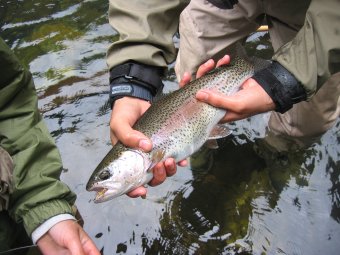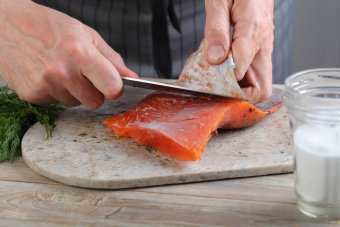
Eating Fish Safely
Tips for Catching, Preparing, and Cooking Fish and Shellfish
Chemicals like mercury and PCBs or biotoxins like domoic acid can build up in fish or shellfish. You can reduce your exposure to harmful chemicals in fish and shellfish by following the recommendations below. Follow as many of them as you can to protect your health.
Find out more about the risks and benefits of eating fish and additional advice for women 18-49 years and children 1-17 years.
Catching Fish and Shellfish
1. Check for advisories, quarantines, and closures related to chemical contaminants and harmful algal bloom (HAB) biotoxins for water bodies where you fish:
- Chemical contaminants
- Site-specific advisories
- Lakes and reservoirs without site-specific advice
- Rivers, streams, and creeks without site-specific advice
- Coastal locations without site-specific advice
- Advice for species that migrate: American Shad, Chinook Salmon, Steelhead Trout, Striped Bass, and White Sturgeon
- HAB biotoxins found in the ocean
- The California Department of Public Health’s annual mussel quarantine and other marine shellfish biotoxin-related closures available via the 24-hour Shellfish Biotoxin Information Line: 1-800-553-4133
- The California Department of Fish and Wildlife’s list of biotoxin-related advisories and closures for marine waters
- HAB biotoxins found in freshwater and estuaries
- Check the HABs portal for information on freshwater and estuarine HAB-related biotoxins and follow any advisory signs.
- If you are concerned that a HAB might be present, avoid eating shellfish and practice healthy water habits.
2. Choose low contaminant species
- Although contaminant levels within the same species vary widely depending on location, in general:
- Rainbow Trout and various sunfish species (e.g., Bluegill and Redear Sunfish) often have lower levels of contaminants.
- Shark species, Pikeminnow, White Sturgeon, Striped Bass, and black bass species (e.g., Largemouth, Smallmouth, and Spotted Bass) often have higher levels of contaminants.
3. Eat smaller fish
- Chemicals can build up in fish as they age.
- Within the same species, larger fish are likely to contain higher levels of harmful chemicals.
- Consider catch and release for large fish.
Preparing and Cooking Fish and Shellfish
4. For finfish, eat only the fillet
- Throw away the skin, fat, and guts. Don’t use these parts to make sauces, stock, or chowder because they often have higher levels of some chemicals.
- Don’t eat the reproductive parts (eggs or roe) very often.
- If you think a HAB is present, rinse the fish fillet with tap or bottled water before cooking.
5. For crabs and lobsters, eat only the meat
- Don’t eat the viscera (soft “green stuff” in the body, crab butter, mustard, tomalley, liver, guts, or digestive gland). This is where pesticides, PCBs, and biotoxins can build up.
6. Grill, broil, or bake fish so the juices drain away
- This can reduce the amount of some chemicals in the fish.
- Don’t use fish drippings or broth to flavor the meal.
- Avoid frying because it can seal chemicals into the fish.
- Before smoking a fish, remove the skin and fillet it.
- Mercury is present in the fillet of fish and cannot be removed by any method of preparing or cooking.
7. Cook fish and shellfish thoroughly
- Cook fish and shellfish thoroughly to destroy harmful parasites (worms), viruses, or bacteria found in fish that can make you sick.
Fish, Incident Response, Seafood Safety, and Harmful Algal Bloom Section
Sacramento Office
1001 I Street
Sacramento, CA 95814
Phone: (916) 324-7572
Fish@oehha.ca.gov



